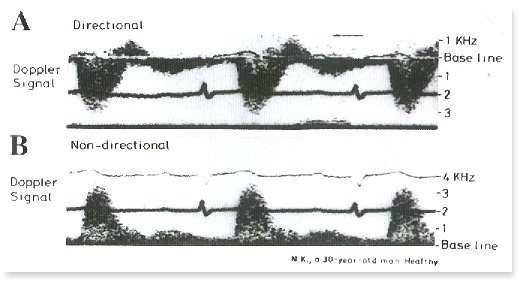The directional doppler technique was a major development in the history of doppler ultrasound. It was developed by K Kato and T Izumi in Japan in 1966, using the local oscillation method (ref). Its was also described independently in the following year in the United States by FD McLeod, based on a different principle, the phase-shift method. McLeod at that time was Research associate at the Department of Surgery, University of Washington, Seatlle, working with D Eugene Strandness and others. He was with the Department of Physiology, Cornell University. The directional doppler technique. A) Flow towards and away from the transducer are displayed under and over the baseline respectively. B) Same flow recorded without directional doppler showing both forward and backward phase overlapping.
Without bi-directional doppler developed, the mesurements we are making today will not be possible or valid.
Source: Yasuharu Nimura "Introduction of the Ultrasonic Doppler Technique in Medicine: A historical perspctive". J Med Ultrasound 1988, 6:5-13.Read also: A brief history of the pioneering work in Doppler applications in Japan.
Ref:
Kato K, Isumi T. A new ultrasonic flowmeter that can detect flow direction. Proceedings of the 10th Scientic Meeting of the Japan Society of Ultrasonics in Medicine. 1966: 78-79. (in Japanese)
Kato K, Isumi T. A new ultrasonic flowmeter that can detect flow direction. Jap Med Ultrasonics. 1967: 5, 28-30. (in Japanese)
McLeod FD. A directional doppler flowmeter. Digest of the 7th International Conference on Medical Electronics and Biological Engineering. 1967, 213.
Back to History of Ultrasound in Obstetrics and Gynecology.
